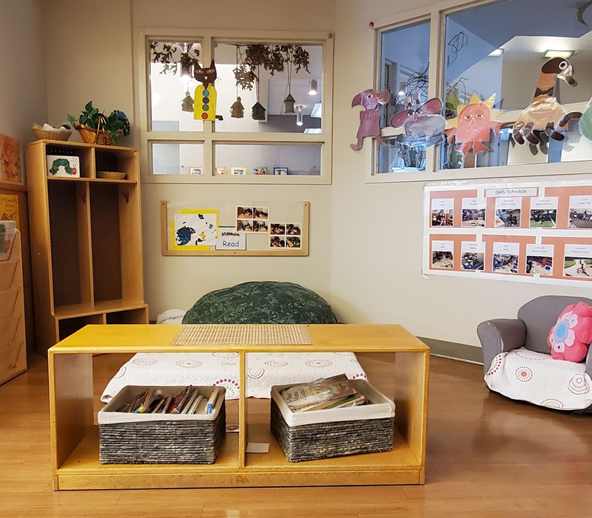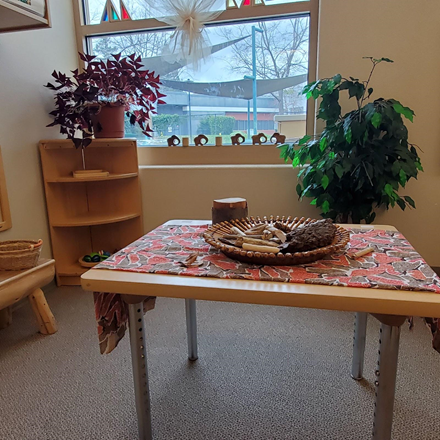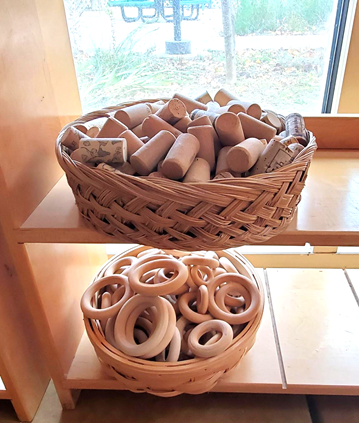10.4: Environments that Support Cognitive Development
- Page ID
- 139905
Cognitive Development and the Environment
Environments are significant in supporting cognitive development because they are both the stimulating backdrop and the active contributor of learning. Therefore, we should change the way we think of environments—we should think of them as learning environments instead of simply physical environments. Learning environments are nurturing spaces that support the development of all young children. They include classrooms, play spaces, areas for caregiving routines, and outdoor areas. Learning environments are well-organized and managed settings. They offer developmentally-appropriate schedules, indoor and outdoor opportunities for choice, play, exploration, and experimentation. Learning environments include age-appropriate equipment and materials They integrate home cultures and are flexible to support the changing ages, interests, and characteristics of a group of children over time. [1]

The educational framework of Reggio Emilia holds the classroom environment to a special status and therefore provides a great perspective to learn about how the environment can support cognitive development. Reggio Emilia was founded by Loris Malaguzzi (1920–1994) to provide provisions for children of the city of Reggio Emilia, Italy, after World War II (Wien, 2008). The Reggio Emilia philosophy perceives physical space as a primary aspect of cognitive development, envisioned as a third teacher (Wien, 2008). What do you think it means to consider the environment as a third teacher? The importance of the environment lies in the belief that children can best create meaning and make sense of their world through environments that support "complex, varied, sustained, and changing relationships between people, the world of experience, ideas and the many ways of expressing ideas.” (Cadwell, 1997). While infants and toddlers are active meaning makers, the quality of materials and interactions in their environments influence the quality of meaning that they can make. [3] [4]
Physically, Reggio Emilia classrooms generally incorporate natural light and indoor plants. Classrooms capture the attention of children through the use of mirrors, photographs, and children's work accompanied by transcriptions. Other supportive elements of the environment include ample space for supplies, frequently rearranged to draw attention to their aesthetic features. The Reggio Emilia environment informs and engages the viewer while always making an effort to create opportunities for children to interact. [4]

With this basic understanding of some of the ideas related to how Reggio Emilia regards learning environments, we can now start to consider important factors for creating learning environments in infant and toddler classrooms. Here are some factors, inspired by Reggio Emilia, to consider for the environments of infants and toddlers: [3]
- Create environments that have an open concept, allowing flow between rooms and amongst areas within a classroom. Windows, indoor plants and materials from nature create a feeling of flow between indoor and outdoor spaces.
- Photographs hung on walls should represent the children, their families and individuals of various cultures who are enrolled in the program and that make up the local community.
- Hang child-created artwork around the classroom ensuring they are placed on walls that are located at heights the children can easily visually engage with.
- Label shelves and containers to support early literacy and help make the process of finding and cleaning easier.
- Consider how the type of storage impacts invitation and ease of access. Storing and displaying materials in clear containers and open baskets visually invites children to play with them and provides easy access without challenging lids to open.

In addition to the overall physical setting of the environment, it is important to consider how materials in the environment are arranged. Reggio Emilia philosophy suggests that children should be allowed to touch, move, listen, see, taste, discover, and explore the world around them in an enriching and supportive environment. Therefore, materials should be developmentally-appropriate, intriguing and easily accessible. Figure \(\PageIndex{3}\)shows two collections of materials stored in baskets on a shelf. How does the storage and arrangement of the materials both invite engagement and allow for ease of access? The materials are stored in open baskets so their contents are visible and easy to access. The baskets are open, without lids, inviting participation. Additionally, the baskets are placed on a low shelf at the height of children. [3]
[1] “Learning Environments” from Head Start ECLK is in the public domain.
[2] Image by Todd LaMarr is licensed under CC by 4.0
[3] Aljabreen (2020). Montessori, Waldorf, and Reggio Emilia: A comparative analysis of alternative models of early childhood education. International Journal of Early Childhood, 52(3), 337-353.
[4] Reggio Emilia approach from Wikipedia is licensed under CC by SA 3.0
[5] Reggio Inspired toddler classroom by Todd LaMarr is licensed under CC by 4.0
[6] Play Materials by Todd LaMarr is licensed under CC by 4.0

